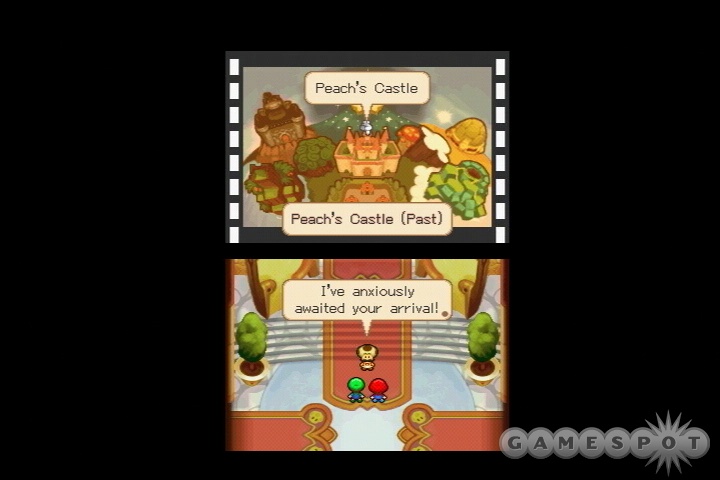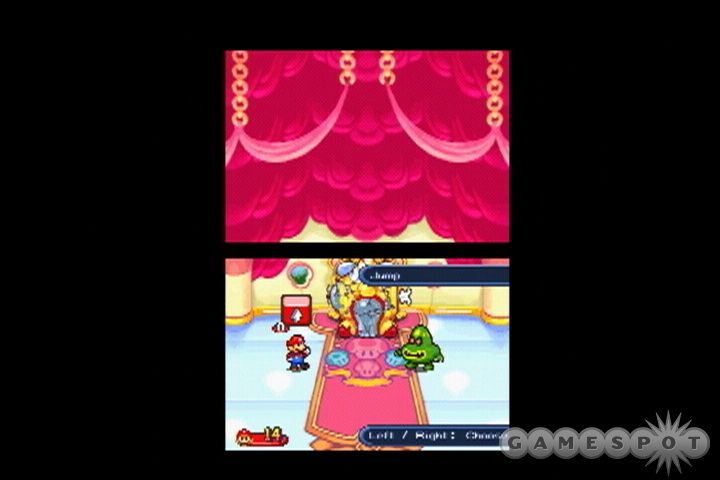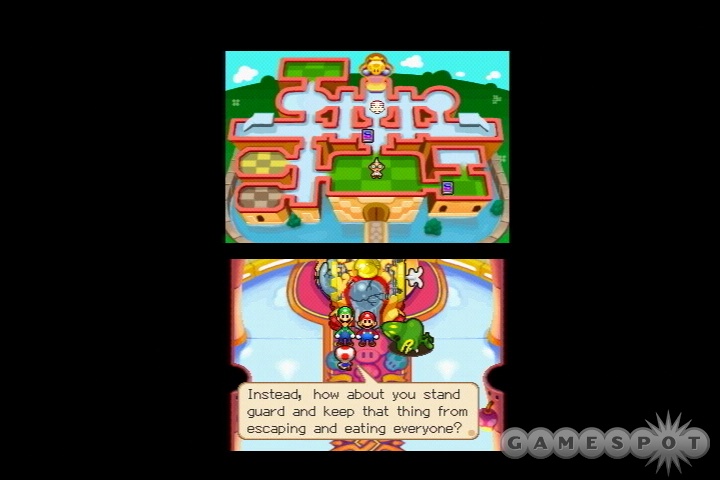Mario & Luigi: Partners in Time Hands-On: Temporal Antics
Go back in time with our updated look at the new DS RPG sequel starring Nintendo's classic plumbing duo.
When it was released in 2003, Mario & Luigi was one of the most unique and endearing vehicles for Nintendo's plumbing power pair in recent memory. The game somehow managed to capture many of the specific gameplay traits--and indeed the very spirit--of the long-running action series and molded them into a lovable and very playable role-playing game. Now developer Alpha Dream is working on the DS sequel, Mario & Luigi: Partners in Time, which we've taken through its paces during the first few hours of the game. We're happy to report that anyone who loved the first one as much as we did will find more of the same solid RPG gameplay, quirky humor, and classic Mario charm that made the first game such a hit.
With Bowser soundly defeated at the end of the last game, peace must have returned to the Mushroom Kingdom...right? Of course not. Even when that dastardly koopa isn't stirring up trouble, you know somebody is going to come along and ruin everyone's day. But unfortunately for Mario, Peach, and friends, the problems in Partners in Time are brewing in the past, when the plumbers are but wee tykes who haven't even grown into their hats. It seems some funguslike aliens called the shroobs have identified the Mushroom Kingdom as a nice place to live, and they've shown up to take over by force. Thanks to a (mostly) trusty time machine and a whole string of unfortunate circumstances, the grown-up Mario and Luigi end up in the past, helping out their infantile selves in the fight against the shroobs--and occasionally, a whiny little Prince Bowser.

One of the best aspects of Mario & Luigi's gameplay was that it let you control the two plumbers somewhat independently of each other, which presented lots of opportunities for the designers to come up with unique puzzles. Well, that same concept is here in the sequel...multiplied by a factor of two. Now you can control Mario and Luigi and Mario and Luigi--that is, the younger and older versions of each hero--all at once. You can still only move two characters around at a time, so the babies can hop right up on the big guys' shoulders when you need to get everyone to the same place.
But those tiny lil' guys can get into lots of nooks and crannies that the big ones can't, so you'll often have to split the party up to go hit some faraway switch in one area to open up a path in another. The DS's two screens are used well here. For example, when you split the party up in different areas, you'll have the babies up top doing their thing, while the older brothers are hanging out down below, and you can switch control between the two groups at the touch of a button.
There are some more-advanced techniques you can pull off using all four plumbers, too. For instance, some blocks are too high for any one brother to reach--so you can have a big brother jump and then make the corresponding baby brother jump at the apex of the first jump, essentially getting you the height of two whole jumps. We've seen some real brainteasers utilizing these mechanics already, and we bet the puzzles will get even more complicated as the adventure wears on.

If you played the first Mario & Luigi (and if you didn't, well, why not?) you'll be quite familiar with the combat engine here, which is basically unchanged. But, of course, the addition of the munchkin versions of the famous plumbing pair has added some new mechanics to the mix, most of which require even more precision timing than before. In situations where you've got all four brothers in the mix, you'll get a chance with every attack to double your damage. For instance, with a jump attack, you'll hit the baby brother's button when you first land, which then gives you a chance to bounce up once and land with the older brother. When you use the hammer, the baby will actually hold the weapon, and your first button press will cause the older brother to stand up so you can hit harder. There's a lot more opportunity for you to screw up here, but when you get used to the mechanics and can nail the timing, you'll be that much more powerful against your foes.
The brothers attacks from the first game are here again, letting you utilize both Mario and Luigi in a single attack against one or more enemies. But this time around, the brothers attacks are more about simple timing and less about hitting a precise and often tough-to-remember sequence of buttons. Plus, you get a full instructional explanation on the top screen each time you use one of these attacks. The green shell attack has you kicking a green shell at an enemy. The shell will quickly bounce back to the other brother, at which point you have to hit his corresponding action button. The shell will hit the enemy again and then bounce back to the other brother, so you'll have to carefully time alternate button presses as the shell speeds up to keep scoring hit after hit. We found the memorization of the last game's brothers attacks a little inaccessible, so we're glad to see that these new ones are more skill-based than before.

Outside the combat, the RPG trappings seem almost identical to the last game. You still collect coins as currency, and you'll pick up pants and badges to equip on your plumbers. All four characters level up independently, and again you can pick a random bonus to each stat when you hit a new level. You've got an amusing new talking suitcase that you'll access as your subscreen, where you'll get to rifle through your items, equipment, and so on. While this is functionally the same as in the first game, the little robo-case is quite chatty and provides both needed instruction and some amusing comic relief.
It seems like the battles are where most of the new meat is, anyway. With all these new mechanics, the designers have come up with some devilishly tough bosses, such as a large caterpillar we fought that was supplying the shroobs' flying saucers with power. The big bug had two helper enemies that whipped out two different kinds of mushrooms from time to time to power themselves up. Hitting one of these enemies will make it drop its 'shroom into the boss's drink. While one kind of mushroom will render the boss helpless for a couple of turns, the other will heal it. So you have to be really careful about using your attacks in this scenario, in order to keep the boss from beating up on you and especially allowing it to heal itself. All of this isn't spelled out for you, either, and we expect there will be a lot of mind-bending stuff like this later in the game.
Mario & Luigi's simple, adorable art style is back in full force in Partners in Time, and thankfully it's just as two dimensional as its predecessor. The character sprites are even more fluidly animated this time around, and there's a lot more subtle shading on both the characters and backgrounds. Though everything is still pleasingly 2D, there is still some occasional, slight use of 3D graphics as special effects, such as when the caterpillar boss slams the ground and sends waves at you that actually deform the surface of the floor. Overall, the look of the game has been totally consistent with that of the first Mario & Luigi, which naturally makes it awfully pleasing to look at.

Some of the sound design is especially noteworthy, especially in the sporadic voice-over. The baby Mario and Luigi have almost revoltingly cute voices attached to them, such as when they go charging into a fight or start crying at unfortunate turns of events. Finally, the expertly localized, incredibly humorous text in the first game is again in evidence here--there has been plenty of imaginative wording, Mario-flavored quips, and even some Internet in-joke phrases like "roxors" and "am cry" flying every which way.
So far, Partners in Time is nicely living up to the Mario & Luigi tradition. We'd hoped to see a little more interactivity with the DS's unique features, like the touch screen and microphone. However, since the game has been rolling out new mechanics at a steady pace, and considering the last one gave us new gameplay elements almost all the way to the end, we hope to see plenty more to do before the end of this game. Mario & Luigi: Partners in Time is due out at the end of the month, so stay tuned for our full review.
Got a news tip or want to contact us directly? Email news@gamespot.com
Join the conversation